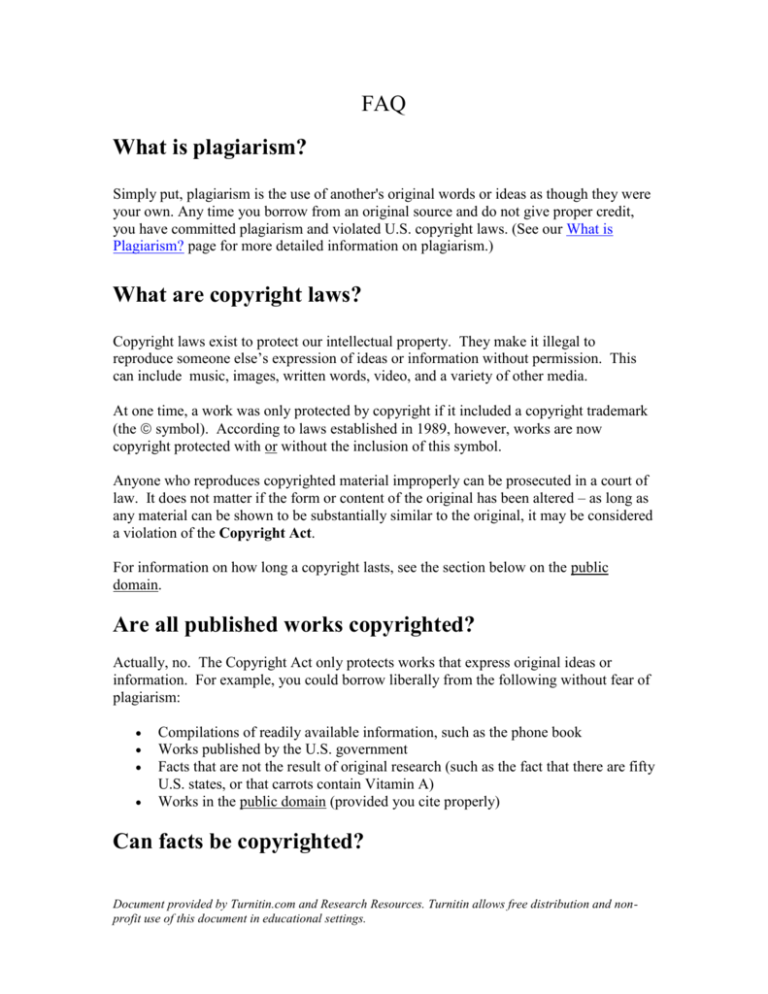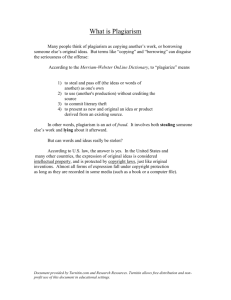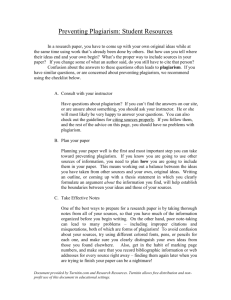FAQ - Plagiarism.org
advertisement

FAQ What is plagiarism? Simply put, plagiarism is the use of another's original words or ideas as though they were your own. Any time you borrow from an original source and do not give proper credit, you have committed plagiarism and violated U.S. copyright laws. (See our What is Plagiarism? page for more detailed information on plagiarism.) What are copyright laws? Copyright laws exist to protect our intellectual property. They make it illegal to reproduce someone else’s expression of ideas or information without permission. This can include music, images, written words, video, and a variety of other media. At one time, a work was only protected by copyright if it included a copyright trademark (the symbol). According to laws established in 1989, however, works are now copyright protected with or without the inclusion of this symbol. Anyone who reproduces copyrighted material improperly can be prosecuted in a court of law. It does not matter if the form or content of the original has been altered – as long as any material can be shown to be substantially similar to the original, it may be considered a violation of the Copyright Act. For information on how long a copyright lasts, see the section below on the public domain. Are all published works copyrighted? Actually, no. The Copyright Act only protects works that express original ideas or information. For example, you could borrow liberally from the following without fear of plagiarism: Compilations of readily available information, such as the phone book Works published by the U.S. government Facts that are not the result of original research (such as the fact that there are fifty U.S. states, or that carrots contain Vitamin A) Works in the public domain (provided you cite properly) Can facts be copyrighted? Document provided by Turnitin.com and Research Resources. Turnitin allows free distribution and nonprofit use of this document in educational settings. Yes, in some situations. Any “facts” that have been published as the result of individual research are considered the intellectual property of the author. Do I have to cite sources for every fact I use? No. You do not have to cite sources for facts that are not the result of unique individual research. Facts that are readily available from numerous sources and generally known to the public are considered “common knowledge,” and are not protected by copyright laws. You can use these facts liberally in your paper without citing authors. If you are unsure whether or not a fact is common knowledge, you should probably cite your source just to be safe. Does it matter how much was copied? Not in determining whether or not plagiarism is a crime. If even the smallest part of a work is found to have been plagiarized, it is still considered a copyright violation, and its producer can be brought to trial. However, the amount that was copied probably will have a bearing on the severity of the sentence. A work that is almost entirely plagiarized will almost certainly incur greater penalties than a work that only includes a small amount of plagiarized material. But can’t I use material if I cite the source? You are allowed to borrow ideas or phrases from other sources provided you cite them properly and your usage is consistent with the guidelines set by fair use laws. As a rule, however, you should be careful about borrowing too liberally – if the case can be made that your work consists predominantly of someone else’s words or ideas, you may still be susceptible to charges of plagiarism. What are the punishments for plagiarism? As with any wrongdoing, the degree of intent (see below) and the nature of the offense determine its status. When plagiarism takes place in an academic setting, it is most often handled by the individual instructors and the academic institution involved. If, however, the plagiarism involves money, prizes, or job placement, it constitutes a crime punishable in court. Academic Punishments Most colleges and universities have zero tolerance for plagiarists. In fact, academic standards of intellectual honesty are often more demanding than governmental copyright Document provided by Turnitin.com and Research Resources. Turnitin allows free distribution and nonprofit use of this document in educational settings. laws. If you have plagiarized a paper whose copyright has run out, for example, you are less likely to be treated with any more leniency than if you had plagiarized copyrighted material. A plagiarized paper almost always results in failure for the assignment, frequently in failure for the course, and sometimes in expulsion. Legal Punishments Most cases of plagiarism are considered misdemeanors, punishable by fines of anywhere between $100 and $50,000 – and up to one year in jail. Plagiarism can also be considered a felony under certain state and federal laws. For example, if a plagiarist copies and earns more than $2,500 from copyrighted material, he or she may face up to $250,000 in fines and up to ten years in jail. Institutional Punishments Most corporations and institutions will not tolerate any form of plagiarism. There have been a significant number of cases around the world where people have lost their jobs or been denied positions as a result of plagiarism. Does intention matter? Ignorance of the law is never an excuse. So even if you did not realize you were plagiarizing, you may still be found guilty. However, there are different punishments for willful infringement, or deliberate plagiarism, and innocent infringement, or accidental plagiarism. To distinguish between these, courts recognize what is called the good faith defense. If you can demonstrate, based on the amount you borrowed and the way you have incorporated it in your own work, that reasonably believed what you did was fair use, chances are that your sentence will be lessened substantially. What is “fair use,” anyway? The United States government has established rough guidelines for determining the nature and amount of work that may be “borrowed” without explicit written consent. These are called “fair use” laws, because they try to establish whether certain uses of original material are reasonable. The laws themselves are vague and complicated. Below we have condensed them into some rubrics you can apply to help determine the fairness of any given usage. Document provided by Turnitin.com and Research Resources. Turnitin allows free distribution and nonprofit use of this document in educational settings. The nature of your use. o If you have merely copied something, it is unlikely to be considered fair use. But if the material has been transformed in an original way through interpretation, analysis, etc., it is more likely to be considered “fair use.” The amount you’ve used. o The more you’ve “borrowed,” the less likely it is to be considered fair use. What percentage of your work is “borrowed” material? What percentage of the original did you use? The lower the better. The effect of your use on the original o If you are creating a work that competes with the original in its own market, and may do the original author economic harm, any substantial borrowing is unlikely to be considered fair use. The more the content of your work or its target audience differs from that of the original, the better. We recommend the following sites for more information on “Fair Use” and Copyright laws. http://www.umuc.edu/library/copy.html http://www.sp.edu.sg/departments/asd/hk_1261.htm What is the “public domain?” Works that are no longer protected by copyright, or never have been, are considered “public domain.” This means that you may freely borrow material from these works without fear of plagiarism, provided you make proper attributions. How do I know if something is public domain or not? The terms and conditions under which works enter the public domain are a bit complicated. In general, anything published more than 75 years ago is now in the public domain. Works published after 1978 are protected for the lifetime of the author plus 70 years. The laws governing works published fewer than 75 years ago but before 1978 are more complicated, although generally copyright protection extended 28 years after publication plus 47 more years if the copyright was renewed, totaling 75 years from the publication date. If you are uncertain about whether or not a work is in the public domain, it is probably best to contact a lawyer or act under the assumption that it is still protected by copyright laws. Document provided by Turnitin.com and Research Resources. Turnitin allows free distribution and nonprofit use of this document in educational settings. Document provided by Turnitin.com and Research Resources. Turnitin allows free distribution and nonprofit use of this document in educational settings.






